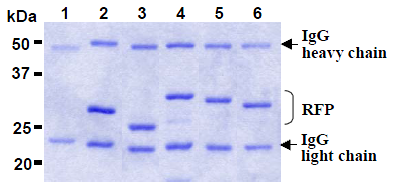RFP-Tag Mouse Monoclonal Antibody [Clone ID: 3G5]
Specifications
| Product Data | |
| Clone Name | 3G5 |
| Applications | IP |
| Recommended Dilution | Immunoprecipitation: 20 μL of gel slurry. For details see protocol below. |
| Host | Mouse |
| Isotype | IgG2a |
| Clonality | Monoclonal |
| Immunogen | RFP |
| Specificity | This antibody reacts with RFP fusion proteins |
| Formulation | PBS Label: Agarose State: Agarose State: 400 μg of anti-RFP monoclonal antibody covalently coupled to 200 μL of agarose gel and provided as a 50% gel slurry, total volume of 400 μL Preservative: 0.09% sodium azide |
| Conjugation | Agarose |
| Storage | Store at 2-8 °C. |
| Stability | Shelf life: one year from despatch. |
| Database Link | |
| Background | Expression vector containing a tag sequence is commonly used to introduce and express a specific gene into a target cell. Red Fluorescent Protein (RFP) fusion protein expression system is preferably used in various laboratories, because it’s easy monitoring of fusion proteins. This specific antibody for RFP is useful tool for monitoring of the fusion protein expression. |
| Synonyms | Red fluorescent protein Tag, DsRed Tag |
| Note | This product was originally produced by MBL International.
Protocol: Immunoprecipitation |
| Reference Data | |
Documents
| Product Manuals |
| FAQs |
| SDS |
{0} Product Review(s)
Be the first one to submit a review






























































































































































































































































 Germany
Germany
 Japan
Japan
 United Kingdom
United Kingdom
 China
China




